- Bernard Preston homepage
- Solar geek
Day in the life of solar geek Bernard Preston
Day in the life of solar geek Bernard Preston is about using the sun's energy to our own advantage.
Most solar home-builds are projects under construction; this page traces our eight year journey, and right at the end you can read about how our lead crystal batteries have been surplanted by lithium ion. Today, I would go straight to the latter if I was you.

This page was last updated on 3rd March, 2022 by Bernard Preston.
It is 5.30 and another day in the life of solar geek Bernard Preston; as is my custom I start simultaneously doing my "lower back exercises," and saying the Lord's prayer in Dutch. Who says a male cannot do more than one thing at a time?
Everyone who sits a lot as I do at this computer, or does physically hard work but does not like pain, should do these little exercises; they take less than two minutes. You can find them using the site-search function in the navigation bar above.
Then I like to keep my Dutch up to speed; it took so much energy and commitment to learn the language that I do not want to lose it. Listening to classic FM at my computer keeps my ear well tuned into good music; and the third most difficult tongue in the world.
This is a long and perhaps arduous page outlining just what you can expect from the sunshine beating down on your PV panels; photons of light are captured and their substantial energy is turned into a usable voltage that can charge batteries.
The batteries then supply the inverter with direct current; the device steps up the voltage and turns it to AC.
A leaf of lettuce does something similar but using a different process called photosynthesis.
Before I turn on the inverter, I check the battery voltage. It reads 52.1V which means it is 80 percent full according to the logger; that is fine. Already light is filtering in and the photovoltaic panels are registering 25 watts; it is going to be another hot and sunny day in Africa.
I carefully wash my face, hearing the reservoir pump kick on, but it is still using mains power. It would drain my relatively small battery bank unless there is full sunshine. Yesterday I did a foolish thing and had an unfortunate encounter with an African killer; it cost the bee her life, and I have a swollen eye. I rinse it carefully.
At this hour there is only enough energy coming from the eastern sky for LED lights and an Apple computer, or any laptop.
Treading the stairs, tray of tea in hand, I quickly scan the daily bad news and emails before writing a chapter for my next book; it concerns the first married pope in a millennium. You will get to read it in a year or so.
Meantime Bernard Preston has six other books to entertain you.
Day in the life of solar geek Bernard Preston
Day in the life of solar geek Bernard Preston looks at just what this electricity from the sun can do in the home.
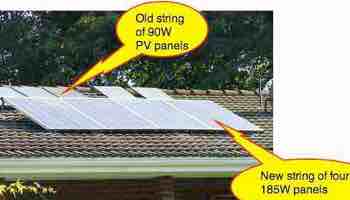
It's 7am and I hear the good wife stirring. I peer quickly to be sure, and yes, there are now 600W arriving from Mr Golden Sun; the first direct rays are reaching the panels.
Residential solar panels like these can be put to good work to generate electricity for your home and supply many off-grid installations such as operating gate motors and water pumps.
I flick the change over switch, moving the whole house over to the solar generator. We have to be careful and conservative with electricity for an hour until the photovoltaic panels really start churning out plenty of free energy; still, there's enough for a pot of filter coffee.
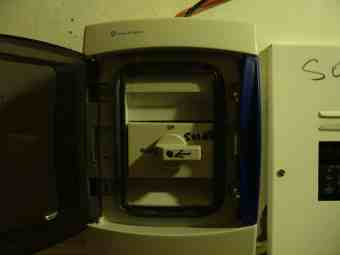
I have a manual solar system. You can for a handsome fee purchase a fully automated generator. Mine is home built; cheap but not nasty.
The total cost was about 13,000 dollars, but a third of that is the batteries; in a country with reliable, clean electricity you could be grid-tied instead.
Perhaps I should say cheaper; thirteen thousand dollars is a fair sum but, as you will soon read, it really performs well. Our total electrical usage from the utility is about 25kWh per month, mostly for LED floodlights and the reservoir pump at night; toilets must be flushed.
And sometimes after a hot day in the life of solar geek Bernard Preston, digging potatoes, or splitting firewood, he needs a shower after sundown.
So using the solar generator, I grind the beans, brew the coffee and froth the hot milk. Living for seven years in Holland cured me for ever of the instant brew. The percolator draws 900W for a short time and the system handles that with ease, even at this early hour.
Before long my wife and daughter will have two washing machines running simultaneously; they do not draw much current, using water from the solar geyser.
The dishwasher draws rather more and is only used during the sunny hours.
Another sunny day in the life of solar geek Bernard Preston
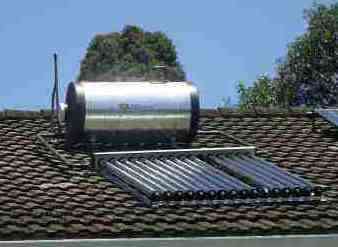
A long and indulgent hot water shower costing nothing is one of the benefits that a solar geek can look forward to; the lovely soft rainwater is captured and stored in our rainwater reservoir; the self priming pumps are driven by the sun. It leaves no carbon footprint.
I don't buy into the philosophy that we must be exceedingly stingy with our water; by reorganising your home, you can enjoy half an hour in a shower like this with no detrimental effect on the environment.

Whilst they are busy, I spend about five minutes throwing in the makings of our homemade loaf; it only takes few moments to prepare the dough and get it into the solar electric breadmaker; it draws very little current until the last 50 minutes in the baking cycle; that's just before noon when there is plenty of energy from the sun, even with the solar pool pump on continuously.

Every day in the life of solar geek Bernard Preston, he starts with three cups of tea, a pot of filter coffee and then we enjoy a hot breakfast, so it's not long before I have an onion frying in butter on the portable induction stove; that's a must whether you are going solar or not. It works faster than gas and uses less than half the electricity of a conventional spiral plate.
In another few minutes I'll be adding the makings for eggs Florentine; a must if you lack energy, are concerned about your cholesterol, or are banting. That's the easiest way to lose weight by the way.
Type "banting diet" into Site Search in the main menu above.
Induction cooktop stoves are a must for every family; shop around and you can find them for about $30. That's what ours cost from Aldi in Holland. Far superior to either gas or the conventional electrical element, they are the future.
I see Frigidaire make a four-plate induction hob for $599, but it's sold out for good reason.
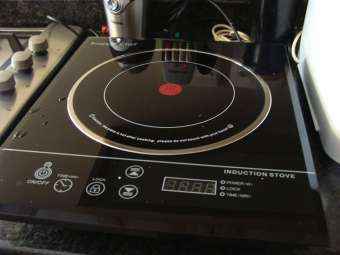
And of course, the toaster too works on solar energy; it draws quite a lot of current but only for a short time.
It is 8.30 and there are 1400 watts coming in now from the sun, so I flick on the swimming pool pump and chlorinator; together they draw about one kW and they run for most of the day, unless we are using any other heavy equipment like the electric mower, or my carpentry tools.
Newsletter
Our newsletter is entitled "create a cyan zone" at your home, preserving both yourself and Mother Earth for future generations; and the family too, of course. We promise not to spam you with daily emails promoting various products. You may get an occasional nudge to buy one of my books.
Here are the back issues.
- Lifestyle and ideal body weight
- What are ultra-processed foods?
- Investing in long-term health
- Diseases from plastic exposure
- Intensive lifestyle management for obesity has limited value
- A world largely devoid of Parkinson's Disease
- The impact of friendly bacteria in the tum on the prevention of cancer
- There's a hole in the bucket
- Everyone is talking about weight loss drugs
- Pull the sweet tooth
- If you suffer from heartburn plant a susu
- Refined maize meal and stunting
- Should agriculture and industry get priority for water and electricity?
- Nature is calling
- Mill your own flour
- Bake your own sourdough bread
- Microplastics from our water
- Alternative types of water storage
- Wear your clothes out
- Comfort foods
- Create a bee-friendly environment
- Go to bed slightly hungry
- Keep bees
- Blue zone folk are religious
- Reduce plastic waste
- Family is important
- What can go in compost?
- Grow broad beans for longevity
- Harvest and store sunshine
- Blue zone exercise
- Harvest and store your rainwater
- Create a cyan zone at your home
It is a lazy Saturday morning in a day in the life of solar geek Bernard Preston; with no chiropractic patients, after a leisurely breakfast we stop and discuss matters. Shall we rinse everything by hand, or use the dishwasher? The latter gets the nod which lets me off the hook.
My daughter puts on her dishwasher; in the drying cycle that does draw a lot of current; the last ten minutes or so. It is also fed with hot water from the solar geysers.
All along the swimming pool pump and chlorinator were running; they draw together about a kilowatt. During the last ten minutes of that dishwasher cycle I thought it was wise to turn off the pool pump, just to be safe as a cloud or two had drifted across the sun.
You do not want to hammer the batteries; they are the most expensive item in a solar generator, so you need to care for them.
This is no longer necessary since putting in our mobile solar carts; we now have plenty of energy and no longer have to fuss with micromanaging our electricity use.

Then it was time for Helen and I to take showers, that reservoir pump
draws 750W, which is no sweat. A long indulgent hot shower is one of the
luxuries I allow myself; free rainwater from the reservoir, heated
yesterday by the sun and stored in the hot water heater, and no cost electricity from the sun
to drive the pump.
Then the breadmaker came on just before lunch; it draws nearly a kW but in bursts so there is plenty of energy at midday.
After a few chores, it is time for a cup of tea; that kettle draws a heavy 2.2kW but it is only for a couple of minutes; there are by 11am well over three kilowatts of energy coming from Mr Golden Sun. The inverter handles it with ease, and the batteries hardly dip, despite the pool pump being switched on.
The clouds have cleared off so I have no concerns when I hear the bread machine come on to the baking cycle; the sky is providing a steady 3.6kW so there is plenty of energy.
It is the heat of the day, so the two fridges and a deep freeze are drawing current too, but not much. It is all about managing your power usage. We could have an airconditioner on solar but living at 4000' above sea level, it is rarely that hot and humid.
A day in the life of solar geek Bernard Preston
Watch your toes and the cord, Bernie. If you have a 10kW inverter you can power anything in the home; even an inverter-welder is not a problem.
I can and do weld without a hassle; the inverter handles it with ease.
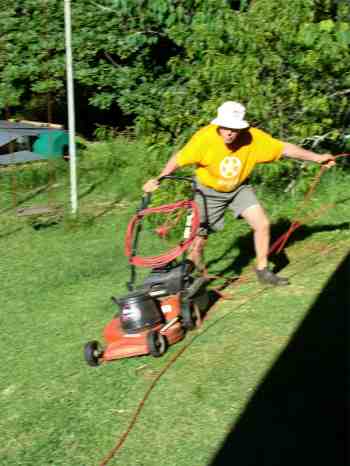
Should a day in the life of solar geek Bernard Preston include mowing
the grass? It is hot and humid and I feel like a good book and siesta
after lunch. Instead, smitten by my conscience, I get out the solar
electric lawnmower. It draws 3kW and previously the pool pump ad to go off first; that's no longer necessary as you can read lower down since I have added three more large west facing panels.
In South Africa we are gravely concerned about the real possibility of a total blackout; if I was to build a solar powered generator again, I would do it differently. Instead of putting the photovoltaic panels on the roof of our home I would build a dedicated extra workshop, using the PVs as the cladding instead of tiles. Then I would have plenty of panels, and there would be none of these concerns about too many appliances on at once. Ten kilowatts in total would be ideal.
We now in fact have 5.5kW of PV panels; the beauty of each day in the life of solar geek Bernard Preston is the planning of each new addition.
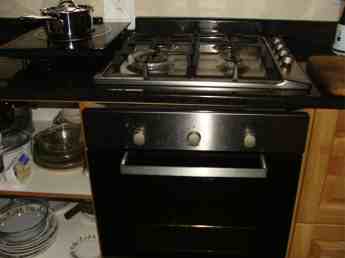
A gas hob is ideal for those rainy days, should there be a utility rolling blackout, as happens frequently in South Africa. Then we simply can't bake with the solar electric oven, but we do have hot food.
My daughter knows she must get dinner into the oven before 3pm if she wants it cooked for free. I hear her busy with a couple chickens, potatoes and butternut from the garden. During the time her solar electric oven is heating up, she drops the breaker to the pool pump for about twenty minutes just in case we turn the kettle on; once it is hot she can switch it on again.
Finally we grasped the nettle; to avoid these hassles we upgraded to a 10kW inverter and and another 5,000 watts of PV panels.
All through the day the router and computers will be on periodically but they use very little current; television too if there is cricket on, but it is rare that we watch TV during daylight hours. There are too many other far more exciting things to be done; I prefer having fun myself to watching others enjoying themselves.
It is 4.30pm and it is an important moment in the day in the life of solar geek Bernard Preston; he turns off the solar swimming pool pump, and returns the change over switch to mains; in the event of a rolling blackout, with full batteries we would have energy to go through the evening, but it stresses the batteries and shortens their expected life of about ten years; we use mains at night for cooking. I am like a mother hen with the batteries; they are very expensive. I am hoping there will be new developments in a decade when I am again in the market. In fact the Redflow and Powerwall are both looking very interesting.
We will have an electric car by then, I could even use its battery as a backup for our home at night; even now, I am looking at a Zero, the electric motor cycle that can do 0-100 in 3 seconds; it is still too expensive for me.
Buy LED light bulbs
Buy LED light bulbs is the first step in anyone wanting to save money and use less electricity. When I first started only GU10 fittings were available making each day in the life of solar geek Bernard Preston busy and sometimes repetitive; now it is easy with bayonet and screw type fittings readily available.
9pm. It is bedtime after a long day in the life of solar geek Bernard Preston; it is time to turn off the computers and most interior lights; the outer floodlights remain on mains all night. Only buy LED light bulbs for your home.
I turn off the big 10kw inverter, noting the batteries are still 90% full; it has been a good day in the life of solar geek Bernard Preston. It could be a good day in your life too.
The capital cost
The capital cost is large means that for most of us saving for a solar farm is the only way to eventually get off the grid. Could your family go without Christmas and birthday presents, and perhaps the annual holiday, so that years of benefits could flow?
Could you be a solar geek too?
Yes, you could build a solar powered generator too provide you are reasonable with your hands, and are ready to talk to the experts and get advice; you'll find many of them feel free to help you. I am not an electrician but I do love to tinker. Each day in the life of solar geek Bernard Preston is full and fun; yours could be too.
But you will need some understanding of subjects like how diodes work; read up on because they are very useful little bits from Silicone Valley.
Here are two important tidbits; plan to go big from the beginning. You will find the greed factor kicks in when you realise all this solar energy is free; you'll want more of it. The solar powered generator upgrade that I went through are quite unnecessary; and costly.
Go straight to a 48V system when choosing an inverter for home. Lower voltages are available but that means high current and bigger losses; and the inability to expand your arrays of panels.
However, think first about the 12-24-48V solar generator. It will mean the added cost, but also much greater efficiency of four batteries as against only one.
Consider putting the PV panels on the ground or making them into the roof of a dedicated workshop or extra garage; I might still do that. Watch this space.
I have built this solar generator for a number of reasons; best of all though, these days in the life of solar geek Bernard Preston have been a lot of fun. I have enjoyed every moment, and am still loving it. And reaping the benefits of reliable and cheap electric power; pay back time is estimated to be 10-13 years by some but I'm thinking shorter because I have the best batteries and never drain them, and we never have electronic equipment damaged by surges.
That is excluding the damage done by dirty power from the South African utility, Eskom. Many folk have had TVs, computers and fridges blown by the surges and brown outs. Their poor management, and racist sidelining of competent engineers and managers has now resulted in their stock being downgraded to junk status; to build new power stations they have applied to the energy regulator for a 23 percent increase in the price of electricity. The real payback time, taking all these factors into account is really 7 to 10 years.
They got their 23 percent, and the next year it was 16%; for 2018 they have applied for 31. Despite having all the solar system facts at your finger tips, this makes planning very difficult.
The solar charge controller MPPT is a vital part of the whole; often it is now built into the inverter, which has some disadvantages. It needs to be big enough to cope with surges from the solar lens effect.
There are three kinds of residential solar PV systems; know the difference before you make a start.
Is there anything that solar can't handle?
Not really; my big 10KVA inverter and 5.5kW of PV panels since adding the mobile solar carts are up to virtually anything. The only device I do not like to use is the thicknesser/ planar; it jams now and then, and then the current skies; actually I am using it freely; that happened only once.
Or my welder; these new inverter welders draw amazingly little current, but I am a little anxious about the arcing. That Big Boy cost a lot of money, so I weld on mains power. The manufacturer says it will be fine; he is right and I now use it without doubts.
Mm, having said that, supplying power to two homes is needing more panels now; I am cogitating; it is done.
Until I have more PV panels I just cannot run everything at the same time without thought or concern; micromanaging our energy use was a schlep until I added the three mobile solar carts.
Of course, when the three day spring rains arrive there'll only be enough for computers and lights; so we haven't gone off grid. Yet; and probably never.
Update: As you have realised we are powering two homes, and now that ovens, dishwashers and hot water kettles are being used, there is sometimes not enough energy for the swimming pool; more west facing PV panels are in the planning.
Update: I've just bought three very large panels supplying 305W each;
they get more powerful and cheaper all the time. More about them in
another blog on a future day in the life of solar geek Bernard Preston.
With 5.0kW of sunshine my system is now big enough; all I might one day consider is becoming grid tied, but that's not legal currently where I live. We do have a large excess periodically when the dishwasher and breadmaker are not busy that could be pumped back into the national grid.
The only problem is that the grid has dirty power and is unreliable. Luckily my inverter was switched off when this surge came through last week, causing havoc down our street. It is time to revisit going off the grid.
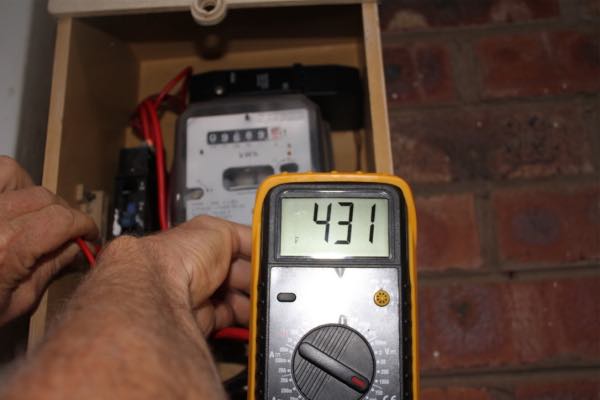
Changing fluorescent light fittings to LED
Whilst replacing most incandescent bulbs with LEDs is absolutely routine, a small change has to been made to a fluorescent tube fitting to accommodate an LED tube. Having said that, changing your fluorescent light fittings to LED is really very simple. All you need is an electrical screwdriver and a short length of single core copper wire. This is one of the simpler things, but very important in a day in the life of solar geek Bernard Preston.
Just another day in the life of solar geek Bernard Preston. You could be a nutcase too, but do switch off the mains before fiddling.
My wife's an Agatha Christie fan and she has got the perfect murder all worked out. Wait for yet another day in the life of solar geek Bernard Preston and when he is working on one of his electrical problems, turn on the mains breaker. Now I have to wait for her to leave the house before venturing to do a solar job.
Going off the grid
Going off the grid is a bit of pipe dream as far as I'm concerned. Unless you have enough dollars for a very large battery bank. And if you do, then a solar gate motor is a must. Each day in the life of solar geek Bernard Preston, and yours, remains simpler if you stay on the grid.
But when the grid is unreliable and sends you dirty electricity then it is an option that sometimes has to be faced; we are looking at it again.
And even then it is cold showers if you have an extended period of inclement weather; we are considering a gas standby for rainy days. That is the opinion anyway from a day in the life of solar geek Bernard Preston; others have their own ideas.
Another serious disadvantage of going off the grid in a country with an unstable utility that resorts to load shedding is that it also causes the inverter to shut down to protect any electricians working to repair the systems; despite the fact the sun is shining brightly, you are still unable to utilise solar power.
This dilemma is discussed fully at another blog at grid tied residential solar power. The long and the short of it is that you need a second inverter and a battery bank. My advice if you are living in a country with an unstable utility power supply is not to go for a grid tied system. Rather use a change over switch to toggle back and forth from solar to the grid; you cannot put energy back into the grid, but for the majority you only have a small surplus anyway; the extra cost is not justified.
Whether you are going off the grid, or staying on, as I have chosen to do, safety is paramount; this knifeblade fuse is in my opinion very important in the event of a short circuit; there is a huge amount of energy stored in those batteries.
- Go off the grid with solar ... another viewpoint.
West facing panels
When the idea of facing a portion of my array directly west arose, instead of north, I immediately saw the sense of it. We have more than enough power during the day, but not enough in the late afternoon; in the early morning too. That means more challenges for the next day in the life of solar geek Bernard Preston.
First I had to consider the effect of shadows on PV panels and, having discounted that, wrongly as it turns out, I am about to put up three large west-facing panels. Watch this space.
The 300W panels are purchased, the frames have been welded and now they must be erected. That is no mean feat a story up on a west facing wall.
West facing solar panels are something else; I decided on a situation quite different, taking those shadows into account.
About another kilowatt of east facing solar panels are in the offing too to give us plenty of early morning power for cooking our breakfast.
Unfortunately they are also going to mean an extra MPPT. My 60A draws close to the maximum, and the new panels will add an extra 20A of power. The sunshine is free, but collecting and storing it does cost a pretty penny; it is still cheaper and more reliable than the utility though.
Finally the decision was made to put the panels not on the wall but on the west facing roof; it was the right decision. Those three panels, in total 915W produce more energy than the 3200W of north facing PVs in the late afternoon; a very needed boost when the oven is often going on.
Every day in the life of solar geek Bernard Preston is busy; are you too enjoying a full retirement, or does time drag and you keep getting under the wife's feet? Think about these retirement sentiments. I've just spent four days soaring the mountains in the hinterland of South Africa, despite being nearly seventy, in a glider; your days too should be filled with something absorbing if you plan to live long in the land.
Gliding and the garden are what turn me on, after tinkering with the solar generator; mm, how could I forget the bees; just harvested 190 pound jars of honey. Even our easy homemade vanilla ice cream is made using solar electric appliances and honey for sweetening.
Mobile solar panels
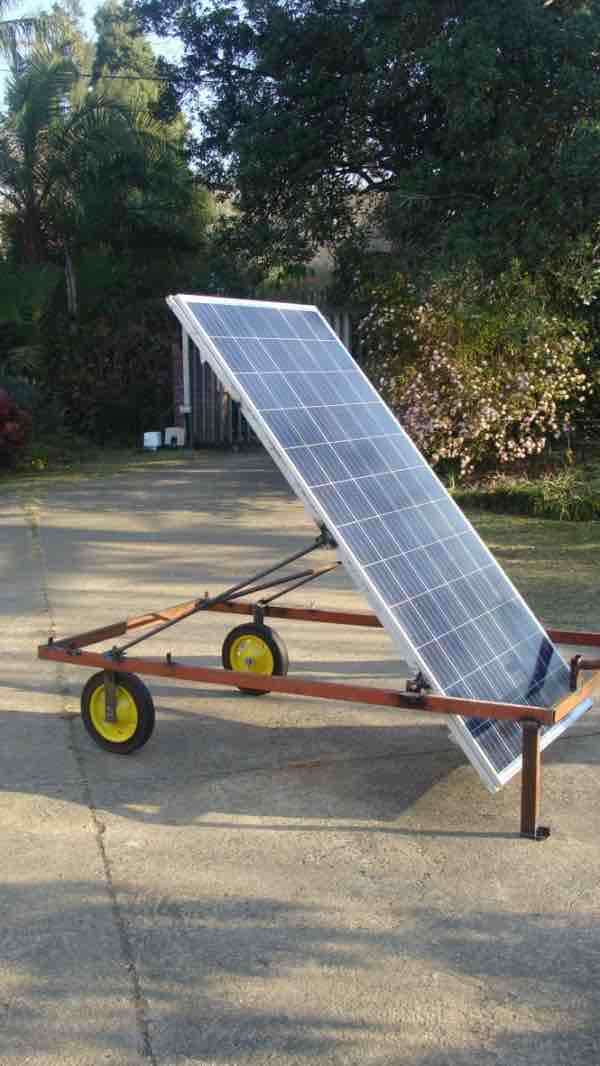
Right now solar geek Bernard Preston is having fun with a new project; I want to have my morning coffee using sunshine, and she who must be obeyed has not enough power in the late afternoon for dinner. So I'm building mobile solar panels using a little buggy; the final construction differed considerably from the one above; those shadows were a problem.
Every day in the life of solar geek Bernard Preston just got more difficult; three four times a day these mobile solar panels need to be turned to follow the sun, and the pitch changed.
One big advantage is that you can easily change the residential solar panels pitch; I am getting nearly double the output from them because they stay close to 90 degrees to the sun throughout the day.
Refrigeration using solar power
Cooling in the home, airconditioning excepted, draws surprisingly little electricity and of course it is mainly needed during the daylight hours when your solar generator is pumping. In our two homes we are needing refrigeration using solar power for four fridges; they draw very little at night when it is much cooler.
Today, purchase only a new fridge using inverter technology; they draw half the current over a year, the variable speed motor idling most of the time.
A neurologist speaking to a group of older folk said that by eighty, one of each couple who have Alzheimer's disease; either you will have it, or you'll be coping with a spouse with it. Whilst diet has much to do with it, exercising the mind is a vital part of prevention; this day in the life of solar geek Bernard Preston is my way of saying a big NO to senile decay; the good wife is equally busy in her own way.
Lithium ion batteries
Most solar systems are projects in development, particularly if it is a home-build. Now finally I have upgraded to lithium batteries. They have dropped quite dramatically in price and are amazingly powerful. Whilst we are not going off the grid, we have changed over to prepaid. There is no longer a constant monthly charge.
There is a downside; I decided this was a job for a professional to install.
E-cars
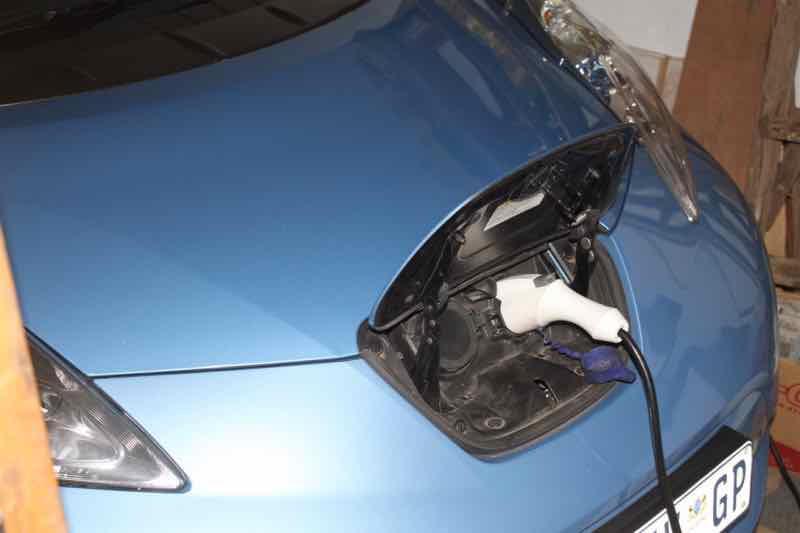
Finally it has happened; we have found a secondhand Nissan Leaf with a new battery at an affordable price. The E-car has landed; the nicest vehicle I have ever owned.
The beauty of it is that you can plug it into a normal mains socket; it draws 2kW, the same as an electric kettle. It takes 7 hours to charge.
Useful links
- Go from a day in the life of solar geek Bernard Preston to solar power energy home page.
- Manual versus automated solar generator.
- How does solar grid-tied work?
When browsing use right click and "Open Link in New Tab" or you may get a bad gateway signal.
Did you find this page interesting? How about forwarding it to a friendly book or food junkie? Better still, a social media tick would help.
- Bernard Preston homepage
- Solar geek
Address:
56 Groenekloof Rd,
Hilton, KZN
South Africa
Website:
https://www.bernard-preston.com